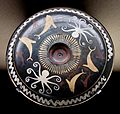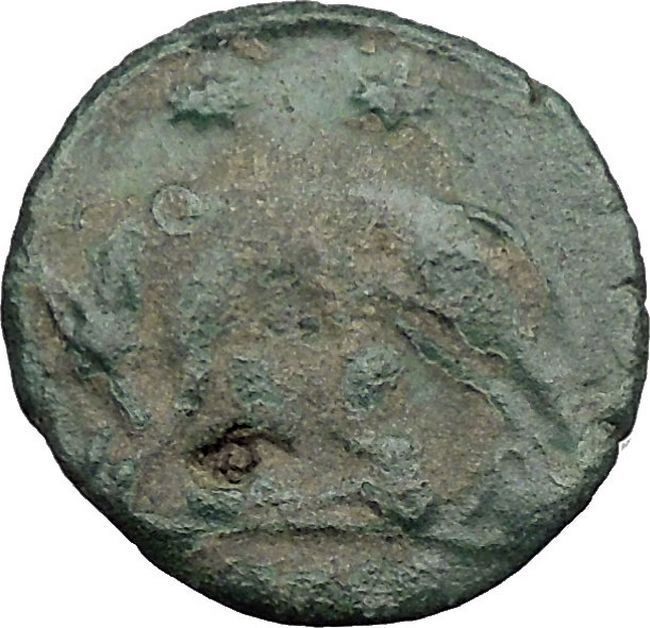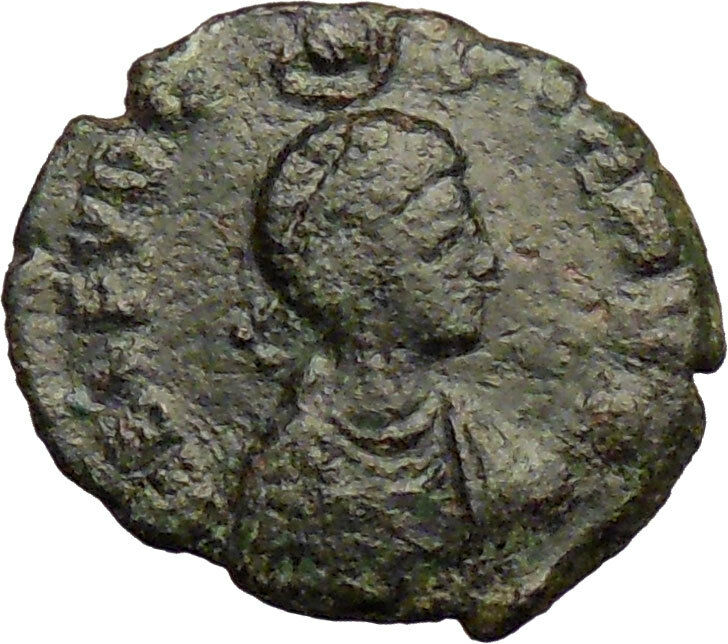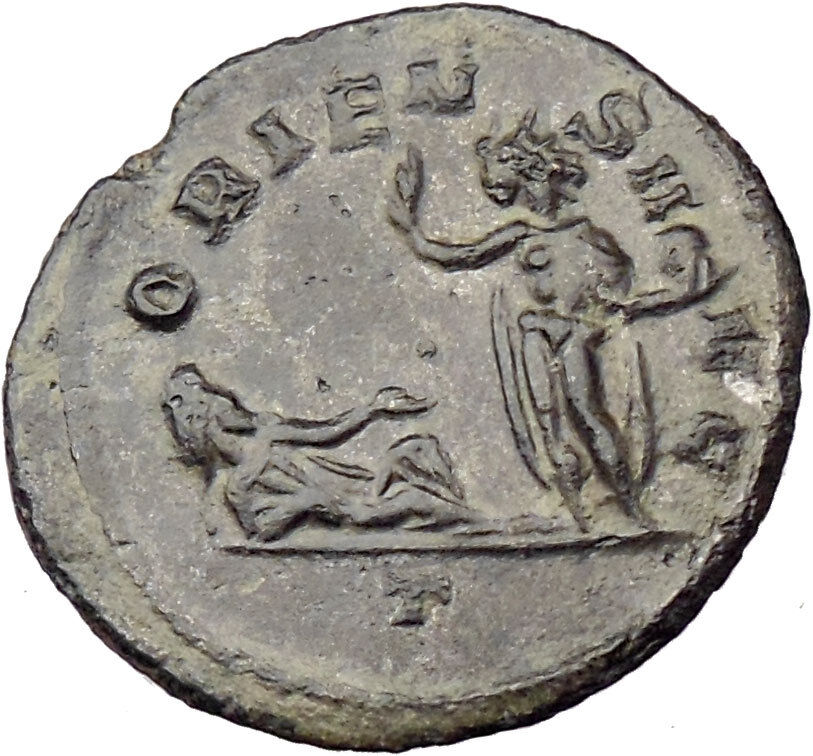|
<=”” font=”” color=”#000000″>Julia Mamaea –
<=”” font=”” color=”#000000″>
Roman Empress Wife of
Emperor
<=”” font=”” color=”#000000″ face=”Times New Roman”>
Severus Alexander
222-235 A.D. –
Silver Denarius 20mm (2.77 grams) Rome mint: 226 A.D.
Reference: RIC 360 (Severus Alexander), BMC 381 (Severus Alexander), S 8217, C
81
IVLIAMAMAEAAVG – Diademed, draped bust right.
VESTA – Vesta standing left, holding palladium and scepter.
You are bidding on the exact item pictured,
provided with a Certificate of Authenticity and Lifetime Guarantee of
Authenticity.

Vesta
was the
virgin
goddess of the
hearth
, home, and family in
Roman religion
. Vesta’s presence was symbolized
by the
sacred fire
that burned at her hearth and
temples.
Vesta’s (in some versions she is called Vestia) fire was guarded at her
Temples by her priestesses
, the
Vestales
. Every March 1 the fire was renewed.
It burned until 391
, when the Emperor
Theodosius I
forbade public
pagan
worship. One of the Vestales mentioned in
mythology was
Rhea Silvia
, who with the God
Mars
conceived
Romulus and Remus
(see
founding of Rome
).
The Vestales were one of the few full-time
clergy
positions in
Roman religion
. They were drawn from the
patrician
class and had to observe absolute
chastity
for 30 years. It was from this that
the Vestales were named the Vestal virgins. They could not show excessive care
of their person, and they were not allowed to let the fire go out. The Vestal
Virgins lived together in a house near the Forum (Atrium Vestae),
supervised by the
Pontifex Maximus
. On becoming a priestess, a
Vestal Virgin was legally emancipated from her father’s authority and swore a
vow of chastity for 30 years. This vow was so sacred that if it were broken, the
Vestal was buried alive in the Campus Sceleris (‘Field of Wickedness’).
It is likely that this is what happened to
Rhea Silvia
. They were also very independent
and had many privileges that normal women did not have. They could move around
the city but had to be in a carriage.
The Vestales had a strict relationship with the
rex sacrorum
and
flamen dialis
as is shown in the verses of Ovid
about their taking the februae (lanas: woolen threads) from the
king and the flamen. Their relationship with the king is also apparent in the
ritual phrase: “Vigilasne rex, vigila!” by which they apostrophated him. The
sacrality of their functions is well compounded by Cicero’s opinion that without
them Rome could not exist as it would not be able to keep contact with gods.
A peculiar duty of the vestals was the preparation and conservation of the
sacred salamoia
muries
used for the savouring of the mola
or mola salsa
, dough to be spread on sacrificial
victims, a procedure known as
immolation
. This dough too was prepared by them
on fixed days. Theirs also the task of preparing the
suffimen
for the
Parilia
.
Temple of Vesta in Italy
In
Greek
and
Roman mythology
, the palladium or
palladion was a
cult image
of great antiquity on which the
safety of Troy
and later
Rome was said to depend, the wooden statue (xoanon)
of
Pallas Athena
that
Odysseus
and
Diomedes
stole from the
citadel
of
Troy and which was later taken to the future site of
Rome by Aeneas
. The Roman story is related in
Virgil
‘s
Aeneid
and other works.
In
English
, since around 1600, the word
palladium
has been used figuratively to mean
anything believed to provide protection or safety, and in particular in
Christian contexts a sacred
relic
or
icon believed to have a protective role in military contexts for a
whole city, people or nation. Such beliefs first become prominent in the Eastern
church in the period after the reign of the Byzantine Emperor
Justinian I
, and later spread to the Western
church. Palladia were carried in procession around the walls of besieged cities
and sometimes carried into battle.
The Trojan Palladium

Ajax the Lesser
drags
Cassandra
from the Palladium.
Detail from a Roman fresco in the atrium of the
Casa del Menandro
(I 10, 4) in
Pompeii.
Origins
The Trojan Palladium was said to be a wooden image of
Pallas
(whom the
Greeks
identified with
Athena
and the
Romans
with Minerva) and to have fallen from
heaven in answer to the prayer of
Ilus, the founder of
Troy.
“The most ancient talismanic
effigies
of Athena,”
Ruck
and
Staples
report, “…were magical found objects,
faceless pillars of Earth in the old manner, before the Goddess was
anthropomorphized
and given form through the
intervention of human intellectual meddling.”
Arrival at Troy
The arrival at Troy of the Palladium, fashioned by Athena in remorse for the
death of Pallas, as part of the city’s
founding myth
, was variously referred to by
Greeks, from the seventh century BC onwards. The Palladium was linked to the
Samothrace mysteries
through the pre-Olympian
figure of
Elektra
, mother of Dardanus, progenitor of the
Trojan royal line, and of
Iasion
, founder of the Samothrace mysteries.
Whether Elektra had come to Athena’s shrine of the Palladium as a pregnant
suppliant and a god cast it into the territory of Ilium, because it had been
profaned by the hands of a woman who was not a virgin, or whether Elektra
carried it herself[8]
or whether it was given directly to Dardanus vary in sources and
scholia
. In Ilion, King
Ilus was blinded for touching the image to preserve it from a burning
temple.
Theft

Odysseus and Diomedes steal the Palladium from Troy. (Apulian
red-figure
oinochoe
of ca.
360–350 BC from
Reggio di Calabria
.)
During the
Trojan War
, the importance of the Palladium to
Troy was said to have been revealed to the Greeks by
Helenus
, the prophetic son of
Priam
. After Paris’ death, Helenus left the
city but was captured by Odysseus. The Greeks somehow managed to persuade the
warrior seer to reveal the weakness of Troy. The Greeks learned from Helenus,
that Troy would not fall while the Palladium, image or statue of Athena,
remained within Troy’s walls. The difficult task of stealing this sacred statue
again fell upon the shoulders of Odysseus and Diomedes. Since Troy could not be
captured while it safeguarded this image, the Greeks
Diomedes
and
Odysseus
made their way to the
citadel
in Troy by a
secret passage
and carried it off. In this way
the Greeks were then able to enter Troy and lay it waste using the deceit of the
Trojan Horse
.
Odysseus, according to The Epic Cycle, in Proclus’s summary of The Little
Iliad, went by night to Troy in disguise and entered the city as a beggar. There
he was recognized by
Helen
, who told him where the Palladium was.
After killing some of the Trojans, he returned to the ships. He and Diomedes
then re-entered the city and stole the Palladium.
Diomedes is sometimes regarded as the person who physically removed the
Palladium and carried it away to the ships. There are several statues and many
ancient drawings of him with the Palladium.
In the Narratives of the
Augustan period
mythographer
Conon
, summarised by
Photius
, on the way to the ships, Odysseus
plotted to kill Diomedes and claim the Palladium (or perhaps the credit for
gaining it) for himself. He raised his sword to stab Diomedes in the back.
Diomedes was alerted to the danger by glimpsing the gleam of the sword in the
moonlight. He disarmed Odysseus, tied his hands, and drove him along in front,
beating his back with the flat of his sword. From this action was said to have
arisen the Greek proverbial expression “Diomedes’ necessity”, applied to those
who act under compulsion. Because Odysseus was essential for the destruction of
Troy, Diomedes refrained from punishing him.
Diomedes took the Palladium with him when he left Troy. According to some
stories, he brought it to Italy. Some say that it was stolen from him on the
way.
Arrival at Rome
According to various versions of this legend the Trojan Palladium found its
way to Athens
, or
Argos
, or
Sparta
(all in
Greece
), or
Rome in Italy
. To this last city it was either brought
by Aeneas the exiled Trojan (Diomedes, in this version, having only succeeded in
stealing an imitation of the statue) or surrendered by Diomedes himself. It was
kept there in the
Temple of Vesta
in the
Roman Forum
for centuries. It was regarded as
one of the
pignora imperii
, sacred tokens or pledges
of Roman rule (imperium).
Pliny the Elder
said that
Lucius Caecilius Metellus
had been blinded by
fire when he rescued the Palladium from the
Temple of Vesta
in 241 BC, an episode alluded
to in Ovid
and
Valerius Maximus
.
When the controversial emperor
Elagabalus
(reigned 218–222) transferred the
most sacred relics of Roman religion from their respective shrines to the
Elagabalium
, the Palladium was among them.
In
Late Antiquity
, it was rumored that the
Palladium was transferred from Rome to
Constantinople
by
Constantine the Great
and buried under the
Column of Constantine
in his forum. Such a move
would have undermined the primacy of Rome, and was naturally seen as a move by
Constantine to legitimize his reign.
The Athenian Palladium
The goddess Athena was worshipped on the
Acropolis of Athens
under many names and cults,
the most illustrious of which was of the Athena Poliás, “protectress
of the city”. The cult image of the Poliás was a wooden effigy, often
referred to as the “xóanon diipetés” (the “carving that fell from
heaven”), made of olive wood and housed in the east-facing wing of the
Erechtheum
temple in the classical era.
Considered not a man-made artefact but of divine provenance, it was the holiest
image of the goddess and was accorded the highest respect. It was placed under a
bronze likeness of a palm tree and a gold lamp burned in front of it. The
centerpiece of the grand feast of the
Panathenaea
was the replacement of this
statue’s woolen veil
with a newly woven one. It was also
carried to the sea by the priestesses and ceremonially washed once a year, in
the feast called the
Plynteria
(“washings”). Its presence was
last mentioned by the
Church Father
Tertullian
(Apologeticus
16.6), who, in the late 2nd century AD, described it derisively as being nothing
but “a rough stake, a shapeless piece of wood” (Latin
original: “[] Pallas Attica [] quae sine effigie rudi palo et informi ligno
prostat?“). Earlier descriptions of the statue have not survived.
See also
Julia
Avita Mamaea (14 or 29 August after 180–235) was the second daughter of
Julia
Maesa
, a powerful
 Roman woman of Syrian Roman woman of Syrian
Arab
origin and Syrian noble
Julius Avitus
. She was a niece of empress
Julia
Domna
and
emperor
Septimius Severus
and sister of
Julia Soaemias
. She was born and raised in
Emesa
(modern
Homs
, Syria
).
Julia’s first husband was a former consul (whose name is unknown) who died.
Julia married as her second husband Syrian
Promagistrate
Marcus Julius Gessius Marcianus
. Julia bore Marcianus two children, a
daughter called Theoclia (little is known of her) and a son, Marcus Julius
Gessius Bassianus Alexianus, later emperor
Alexander Severus
. Unlike her sister, Julia Mamaea was reported to be a
virtuous woman, never involved in scandals.
As a member of the Imperial Roman family, she watched closely the death of
her cousin Caracalla
and the ascent to power of her nephew
Elagabalus
,
the oldest grandson of Julia Maesa and her choice to the throne. Eventually
Elagabalus and his mother Julia Soaemias proved incompetent rulers and favour
fell on Alexander, Julia’s son. He became emperor in 222, following Elagabalus’
murder by the
Praetorian Guard
. Julia and her mother became regents in the name of
Alexander, then 14 years old. Upon adulthood, Alexander confirmed his esteem for
his mother and named her consors imperii (imperial consort). It was in
this condition that she accompanied her son in his campaigns: a custom started
with Julia Domna
. Thus she travelled to the East, for the campaign against
Parthia
and
to the Germania provinces. Julia Mamaea was with Alexander in Moguntiacum
(modern Mainz
),
capital of
Germania Superior
, when he was assassinated by his troops. She suffered the
same fate.
In the
material culture
of
classical antiquity
, a phiale or
patera (Latin pronunciation: [ˈpatera])
is a shallow ceramic or metal
libation
bowl. It often has a bulbous
indentation (omphalos,
“bellybutton”) in the center underside to facilitate holding it, in which case
it is sometimes called a mesomphalic phiale. It typically has no handles,
and no feet. (A drinking cup with handles is a
kylix
. A circular platter with a pair of
C-handles is not a patera, but a few paterae have a single long straight
handle.) Although the two terms may be used interchangeably, particularly in the
context of
Etruscan culture
, phiale is more common
in reference to Greek forms, and patera in a Roman setting.
-
Silver phiale (620-590 BC, from
Bayindir
village,
Elmali
, present-day Turkey
-
Octopus and dolphin motifs on a ceramic phiale (510–500 BC, from
Eretria
,
Euboea
)
-
Golden phiale (4th–3rd century BC)
-
Silver patera from
Hispania
(Roman
Spain), 2nd–1st century BC)
Use

A youth pours a libation to the deceased within a
naiskos
, a scene that may also
represent
Ganymede
serving
Zeus
( Apulian
red-figure
krater
, 340–320 BC)
Libation was a central and vital aspect of
ancient Greek religion
, and one of the simplest
and most common forms of religious practice. It is one of the basic religious
acts that define piety in ancient Greece, dating back to the
Bronze Age
and even
prehistoric Greece
. Libations were a part of
daily life, and the pious might perform them every day in the morning and
evening, as well as to begin meals. A libation most often consisted of mixed
wine and water, but could also be unmixed wine, honey, oil, water, or milk.
The form of libation called spondē is typically the ritualized pouring
of wine from a jug or bowl held in the hand. The most common ritual was to pour
the liquid from an
oinochoē
(wine jug) into a phiale. Libation
generally accompanied prayer. The Greeks stood when they prayed, either with
their arms uplifted, or in the act of libation with the right arm extended to
hold the phiale. After the wine offering was poured from the phiale, the
remainder of the contents was drunk by the celebrant.
In Roman art
, the libation is shown performed at
an
altar, mensa (sacrificial meal table)
,
or
tripod
. It was the simplest form of sacrifice,
and could be a sufficient offering by itself. The introductory rite
(praefatio) to an animal sacrifice included an incense and wine libation
onto a burning altar. Both
emperors
and divinities are frequently
depicted, especially on coins, pouring libations from a patera. Scenes of
libation and the patera itself commonly signify the quality of
pietas
, religious duty or reverence.
-
Libation at a
symposium
(Attic
red-figure cup, ca. 480 BC)
-
Apollo pouring a libation (Attic
white-ground
kylix
, ca. 460 BC)
-
Etruscan priest with phiale (2nd century BC)
-
Roman priest,
capite velato
(2nd–3rd century
AD)
|










 Roman woman of Syrian
Roman woman of Syrian











